
GET SMART WITH YOUR MEMORY Red Hot Summer WHY QUITTING IS SO GOOD FOR YOU QuitThat! Sharpen Up CHILI-INFUSED RECIPES FOR A HEALTH KICK Trust Your Gut The Brain Health Issue ISSUE 68 * JUNE / JULY / AUGUST 2022 * THE BEST EATS FOR GRILLIN’ AND CHILLIN’ Fire It Up! IT FEEDS YOUR MIND









































2
Kids need a healthy, well-balanced diet to get key nutrients; vitamins can be a complement to their diet. TM and © 2022 Sesame Workshop. Sesame Street® and associated characters, trademarks and design elements are owned and licensed by Sesame Workshop. All rights reserved. Brought to you by
webber naturals spread

















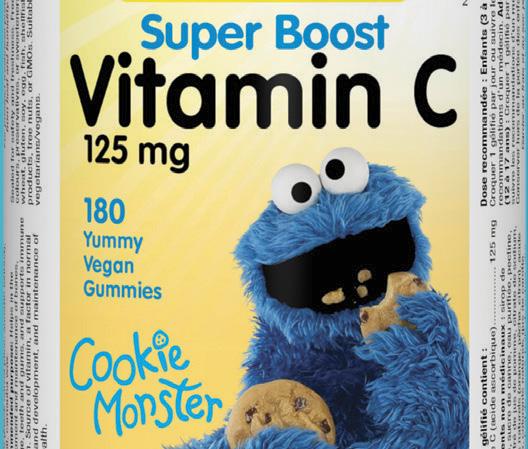



































3 webber naturals spread No aspartame No artificial colours, flavours, or preservatives No gelatin Non-GMO Healthy Habits Start Young! Sesame Street® vitamins are chock full of high-quality ingredients that are rigorously tested and bursting with flavours kids love! Kids need a healthy, well-balanced diet to get key nutrients; vitamins can be a complement to their diet. Pick some up today at your favourite pharmacy or grocer! webbernaturals.com
CEO & Group Publisher • Ryan Benn
Vice President, Publishing & Operations
EDITORIAL
Group Content Director, Editor-in-Chief
Senior Editor • Sandi Gauvin
Editor, CNHR • Bruce W. Cole
• Nina Wagner
Cover
• Tracy Peternell
Editors • Melissa Curman, Erin Jackson, Laura Newton
Digital Editor • Colleen Grant
DESIGN
Group Creative Director & Photographer
• Scott Yavis
Senior Graphic Designers • Iva Zima, Alan Pierce
Graphic Designer • Devanshee Mavani
PRODUCTION
Production Associate • Selena Shiu
SALES
Vice President, Sales
• Ellen Wheeler ext 619
Retail Account Executive, Canada
Sales Coordinator
• Sarah Fuson
Account Executive, USA (East)
Account Executive, USA (West)
Retail Account Executive, USA
• Charles Ho
• Bernadette Higgins
561.362.3955
• Cindy Schofield 310.570.3094
• Rebecca Randolph
EDUCATION & ADMINISTRATION
Vice President, Education & Administration
Executive Assistant • Hannah Dewar
• Jane Griffiths
Manager, alive Academy • Julia Wagner ext 637
Manager, Academy Admissions
FINANCE
Director of Finance • Conroy Ing
• Jan Clay ext 623
Senior Accountant • Maira Guzman
Accounts Receivable Specialist
• Jacqui Harquail
CONTACT INFORMATION
Alive Publishing Group Inc. 100-12751 Vulcan Way, Richmond, BC V6V 3C8
Phone: 604-295-9333 Toll Free: 1-800-663-6580
Cover price is $5.75. Nine issues published per year.
Canada Publications Mail Sales Product Agreement No. 40011604
ADVERTISING POLICY
sage accepts advertising based upon space availability and consistency with its mission to promote a natural health and wellness lifestyle. sage is not responsible for the content of advertisements, the products offered or the viewpoints expressed therein.
EDITORIAL NOTE
The information provided in this magazine is for educational and informational purposes only. It should not be used as a substitute for the advice of a qualified and licensed practitioner or health care provider. The opinions expressed here are not necessarily those of Alive Publishing Group Inc., its affiliates or parent company. Different views may appear in future articles or publications. Articles in sage are copyrighted and must not be reprinted, duplicated or transmitted without permission.
PHOTOGRAPHY
Scott Yavis
@scottyavis
FOOD STYLING
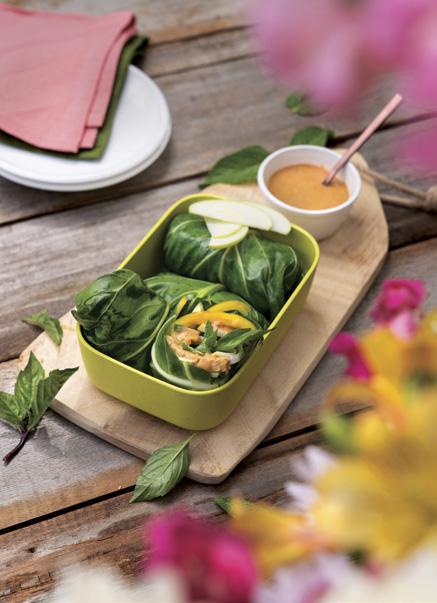
Irene McGuinness
Contributors
Daniela Ginta, MSc
Marsha McCulloch
Kristina Campbell
Lisa Petty
Josh Duvauchelle
Carimé Lane
Matthew Kadey
Irene McGuiness
Amie Watson
Shutterstock Unsplash Scott Yavis 10, 11, 15, 18, 23, 25, 28, 32, 35, 36, 37, 42, 64, 66 6, 9, 11, 16, 26, 27 8, 12,
51,
4
Photography & Illustration credits
40, 43, 44, 45, 46, 49,
52, 54, 57, 58, 59




5

6
Summer is here and our heads are buzzing with opportunity! Blue skies and the thrill of adventures are on the horizon, but even the sunniest days aren’t always enough to keep the brain fog away. The good news is, there are plenty of ways we can clear away those clouds.

In this issue of sage , we’re shining a light on all things brain health. Sharing a silent connection to the rest of our bodies, this impressive organ is entwined in a delicate dance—responding to what we eat, influenced by how we breathe, and listening closely to what the “second brains” in our guts have to say. Our minds are also connected to our environments; a connection that’s impossible to ignore when our day-to-day lives leave us burnt out and drained.
When we are mindful of the brain’s connections, we can proactively protect and support it. With smart recipes that will feed your noggin’ the nutrients it needs, strategies for staying sharp, and the courage to quit in favour of better health, we’re helping you and your brain embrace all the goodness these sunny days have to offer.



8 In every issue 12 TAKE A BREATH Breathe deeply for a clear head and whole-body health 16 STAY SHARP TO 100! Be proactive about protecting your memory 22 TRUST YOUR GUT This “second brain” fuels your mind 26 GO AHEAD AND QUIT It’s time to make room for what serves you—and your well-being 32 BE A FITNESS ROLE MODEL … and inspire the whole family to get moving 36 GREEN BEAUTY Care for your skin and the earth The brain health issue contents 10 64 JUNE/JULY/AUGUST 2022 RED HOT SUMMER Chili-infused recipes to kick up your health FIRE IT UP! The best summer eats for grillin’ and chillin’ LEAFY GOODNESS Diversify your diet by expanding your greens portfolio Recipes 40 46 54 TREND ALERT THE A-LIST

“You are today where your thoughts have brought you; you will be tomorrow where your thoughts take you.”
— James Allen
Trend alert
What’s hot in natural health right now
Crafting for positive well-being
Crafting can bring calm by encouraging you to slow down and tap into your creativity. Studies have shown that taking time to create something, be it a painting or a scarf, can significantly reduce feelings of anxiety and promote positive well-being. In one study, crocheters reported feeling calmer, happier, and more useful after crafting. If you’re new to creative endeavours, get started with a subscription service that will deliver craft projects (and a sense of calm) right to your door.

10
Plant-based retinol for ageless skin

Retinol has long been a favourite ingredient in topical skin treatments for those looking to address aging skin. But if you prefer to avoid animal-derived ingredients, retinol may be a no-go. Fortunately, serums and lotions are hitting the market that feature bakuchiol instead, a plant-based retinol alternative that offers many of the same benefits, including a reduction of lines and wrinkles, a boost in elasticity and firmness, and overall anti-aging effects.
Short runs for brain power
If you’re feeling down or unfocused, try lacing up your running shoes. Recent studies have shown that a quick jog around the block can work wonders at boosting both mood and cognitive function. It doesn’t even have to be a long run; just 10 minutes will do the trick, thanks to increased blood flow to the part of the brain that helps control mood.

Jamu juice to reduce inflammation

Move aside golden milk, Jamu juice just might be the new “it” beverage. This traditional Indonesian herbal tonic is easy to make using simple ingredients like turmeric root, ginger, lemon/lime, coconut water, and honey, and may offer powerful antioxidant and anti-inflammatory benefits. Although it’s typically served cold, don’t hesitate to heat it up. Either way, you’ll enjoy a healthy taste of Bali.
Track mood for better mental health
Whether your therapist or doctor recommended it, or you just want to have a better idea of what affects your mental health throughout the week, tracking your mood can help you identify unhealthy patterns and create strategies for replacing them. You can use a journal to do so, but there are also many apps available to help enhance well-being and relieve depression.

11
Take a BREATH
Breathe deeply for a clear head and whole-body health

WHAT HAPPENS TO THAT DEEP BREATH?
That breath feeds life-giving oxygen to every cell in your body. When you inhale, the air that enters your nose (ideally) travels down the pharynx, larynx, and trachea, all the way to the structures in your lungs called bronchi, which branch into bronchioles.
Along the way, your nose’s blood vessels warm the air; mucus along the way moistens the air for better gas exchange; and your nose hairs, mucus, and cilia (hair-like projections on the surface of your cells) in the trachea clean it up.
From the lungs, oxygen is diffused into the blood and transported throughout the body with each beat of your heart. The carbon dioxide waste from the many chemical processes involved in this gas exchange is diffused into the blood, then back to the lungs, which expel it as you breathe out.
IS THERE A RIGHT WAY TO BREATHE?
We mostly inhale and exhale through the nose. Most of us breathe in a shallow way, without engaging the diaphragm, which is an essential participant in the breathing process. When engaged properly, the diaphragm helps the respiratory system, as well as the cardiovascular, gastrointestinal, and nervous systems, and, of course, the brain.
“Most of us don’t experience the full capacity of what is available to us in our body’s breath,” says breathing coach Alisa Kort, founder and director of Breathexperience Canada. That is not conducive to ease and relaxation, she explains, or having a better sense of oneself.
Cue in that open-window breathing, or a deep sigh that you engage in. That’s what you’re after, says Kort. “Becoming aware of our own habitual breathing gives us the choice to breathe better, which ultimately translates into better health,” she adds.
BREATH AND THE BRAIN
Breathing and relaxation go hand in hand. With deeper breaths, your parasympathetic nervous system (known as “rest and digest”) takes over. Heart rate and blood pressure go down, as well as your levels of cortisol (otherwise known as the stress hormone).
High stress engages the sympathetic nervous system (“fight or flight”). Breathing, heart rate, and blood pressure go up and stress hormones flood your body. When the stressor is gone, the parasympathetic system helps restore the peace, unless the body stays in a state of permanent stress. That’s when intentional deep breathing can help.
By consciously slowing down our breathing, we engage the parasympathetic “brake,” which lowers blood pressure and reduces cortisol levels.
BREATHING TIPS TO CALM STRESS
“There is no one-size-fits-all,” says Kort, “because every breath is different from the next, but everyone will notice positive changes very soon after they start experiencing the sensation of their breath movement.”
Slow your breathing. Aim for six to 10 breaths a minute, ideally breathing in through the nose. You’ll feel calmer with lower blood pressure and heart rate, and your sleep and ability to manage stress will improve.
Try yoga. Through rhythmic breathing and meditation, yoga can have a positive effect on the amygdala (emotion centre), hippocampus (memory centre), and prefrontal cortex (personality centre). Sustained yoga breathing has also been found to improve cardiovascular disease and respiratory issues, such as asthma, and help people diagnosed with diabetes.
13
Think of breathing as something that is constantly there, rather than an activity that you do according to schedule.
It’s a new morning. You open the windows … you breathe in deeply … your upper body expands … and a feeling of calmness settles in. Your body’s hunger for deeper breathing has been temporarily satisfied.
Supplements to help you breathe easier
Ashwagandha is a known adaptogen that has been shown to lower cortisol levels to help relieve stress.
That’s a lot of CO2!
Rhodiola rosea extract may help increase resistance to stress and fatigue.
The scale of the human body’s capacity to bind and transport oxygen to the tissues is astonishing: each hemoglobin molecule can transport four oxygen molecules; there are up to 300 million hemoglobin molecules in each of the almost 30 trillion red blood cells that are circulating in the body at any given time!
L-theanine is derived from green tea and is often used for stress, anxiety, sleep, and mood improvement.
If you suspect sleep apnea
Talk to a specialist who can help you identify the causes and suggest some oropharyngeal exercises that will help your nose regain its place in the breathing hierarchy. Eager to get started before that appointment?
Can cannabis help?
Tetrahydrocannabinol (THC) and cannabidiol (CBD) research is investigating the many potential benefits of cannabis, including for multiple sclerosis, post-traumatic stress disorder, and chronic pain. Cannabis use is also being studied for its ability to improve sleep quality and decrease the need for sleep medication.
• Adopt habits of regular exercise and stretching. They are shown to reduce oxidative stress and inflammation while calming the overactive sympathetic nervous system—all associated with sleep apnea.
• Self-conscious or not, try singing (off key works, too!). It can improve sleep and reduce daytime tiredness levels.
14
WE’RE BORN KNOWING HOW TO BREATHE
Watch babies breathe. You’ll see their bellies move up and down with each breath, even more dramatically when crying. “Their whole body breathes, because their diaphragm moves everything; it is fully involved in breathing,” says Kort.
As they grow, allergies, plugged nasal passages, or jaw misalignment can cause children to breathe more through their mouths.
In the short term, that can translate into a higher risk of cavities, bad breath, and atopic dermatitis. In the long term, mouth breathing can lead to malocclusion (misalignment of the teeth) as well as sleep disorders, including sleep apnea.
DO ADULTS DO IT RIGHT?
Although breathing is the most natural thing in the world, we often develop poor breathing habits along life’s journey. Habits that can constrict natural breathing can develop from asthma and poor posture while sitting or using devices, to obesity and heart disease.
Obstructive sleep apnea, which is defined as a breathing obstruction to the lungs that lasts for longer than 10 seconds, can cause a number of health issues—for the person with the breathing obstruction and everyone affected by the snoring that accompanies the sleep disorder.
HOW DOES BREATHING AFFECT OUR GOLDEN YEARS?
Sleep disordered breathing, which affects almost 60 percent of older adults, can increase the risk of cognitive decline and dementia, specifically Alzheimer’s. Circadian rhythms also become more fragmented, which can impact memory, mood,
By consciously slowing down our breathing, we engage the parasympathetic 'brake,' which lowers blood pressure and reduces cortisol levels.
and cognition. Hypoxia caused by sleep disordered breathing can lead to cognitive impairment.
Enter physical exercise and yoga: both can improve sleep quality. Aside from helping you sleep, better breathing through physical exercise can improve balance, reduce stress levels, and boost lung capacity.
A LAST WORD OF ADVICE
Don’t think of breathing as needing fixing, because we don’t want to become fixated on watching our breath, says Kort. Instead, allow it to permeate your body. Think of breathing as something that is constantly there, rather than an activity that you do according to schedule.
Breathing is what sustains life—it’s only natural that we put our whole being into it.

15
STAY
SHARP
TO 100!
Be proactive about protecting your memory
When you’re in your twenties and thirties, memory loss and Alzheimer’s disease may seem like distant concerns. But taking care of your brain isn’t something you should put off.

Certainly, the vast majority of Alzheimer’s disease is diagnosed in people 65 and older. However, Alzheimer’s cases have been increasing at alarming rates among people between the ages of 30 and 64.
“We’re now seeing people in their fifties, and even their forties and late thirties, with early signs of cognitive decline,” says Dale Bredesen, MD, an internationally recognized expert in the mechanisms of neurodegenerative diseases and author of The End of Alzheimer’s Program (Avery, 2020).
“The brain changes that result in Alzheimer’s disease may start 20 years or more before you’re diagnosed,” says Bredesen. Some experts say Alzheimer’s may more appropriately be called a younger and middle-aged person’s disease.
Now, the good news. Though Alzheimer’s disease was once thought to be something you could do little to prevent, scientists are proving that wrong.
IS YOUR BRAIN IN TROUBLE?
Dementia can impair your memory, thinking, and speech. Alzheimer’s disease is the most common cause of dementia.
“Dementia can sneak up on people because they don’t like to think about the possibility that something is wrong,” says Bredesen. “So, they write off the warning signs.” Plus, the symptoms of early-onset Alzheimer’s (diagnosed before age 65) may not be what you expect.
Later-onset dementia often starts as purely a memory problem and then spreads to other cognitive dysfunction, explains Bredesen. Worsening memory isn’t the only symptom you should be watching out for.
Possible signs of early-onset Alzheimer’s
Younger people with dementia may first experience difficulty with
• speech, such as finding the right words
• organizing things
• recognizing faces or objects
• making calculations, such as restaurant tips
GENETICS AND RISK
Several genes increase your risk for Alzheimer’s disease, but your genetics don’t determine your destiny.
“Scientific evidence shows that several lifestyle changes can reduce your risk of Alzheimer’s disease, regardless of your genetic predisposition,” says Demetrius Maraganore, MD, who leads the Tulane Healthy Brain Aging Initiative in New Orleans.
That said, genetic testing may help you and your health care practitioner better focus your prevention efforts.
“Consider getting genetically tested to see if you carry the apolipoprotein-e4 (APOE-e4) risk variant for Alzheimer’s disease,” says Maraganore. “APOE is one of the approximately 25,000 genes that you inherit—one copy from your mom and one copy from your dad.” The APOE-e4 variant is the strongest genetic risk factor for Alzheimer’s.
People with zero copies of APOE-e4, which is the majority of us, have a 10 to 15 percent risk of Alzheimer’s disease. But those with one copy of the gene variant have an estimated 25 to 40 percent risk, and those with two copies have a 40 to 55 percent risk of developing Alzheimer’s disease.
Your doctor can test you for APOE-e4, or you can use an at-home test kit, such as one from alzheimersorganization.org. For more information, visit apoe4.info.
A COVID connection
Carrying two copies of APOE-e4 has been linked with double the risk of severe COVID-19. This may be due, in part, to the gene variant’s impact on immune function and increasing inflammation, says Bredesen.
SUBTYPING ALZHEIMER’S DISEASE
You may think of Alzheimer’s disease as a single entity. But many different paths can lead to the condition.
Bredesen classifies Alzheimer’s according to the most likely underlying factors in a given individual, including
• increased inflammation due to APOE-e4 genetics
• high blood sugar and insulin resistance, as in prediabetes and type 2 diabetes
• hormonal disruption (such as thyroid issues) and nutritional deficiency
• toxicity due to factors such as air pollution and biological toxins from mold
• vascular disorders, such as heart disease and high blood pressure
• head injuries, such as those sustained in sports or car crashes
Other factors can also contribute to your risk, including obesity, smoking, excess alcohol intake, poor sleep, certain chronic infections, and impaired hearing. Generally, multiple factors are involved, so prevention should be multipronged.
17
Alzheimer’s cases have tripled among Americans aged 30 to 64 since 2013.
Smart supplements
These supplements support brain health. Based on your individual risk factors, other supplements may also be helpful.

B-complex vitamins
Taking B vitamins—including vitamin B6, folate, and vitamin B12—throughout young adulthood has been linked with better brain function in midlife.
Citicoline
This is a potent supplemental source of choline, which is needed to make acetylcholine, a brain messenger critical for memory.
EAT FOR YOUR BRAIN
“The importance of diet in preventing dementia cannot be overemphasized,” says Arnold Eiser, MD, adjunct fellow at the Center for Public Health Initiatives at the University of Pennsylvania. He says the Mediterranean diet appears helpful for reducing Alzheimer’s risk.
Mediterranean diet
The Mediterranean diet, which can also reduce your risk of obesity, heart disease, and diabetes—all risk factors for Alzheimer’s—helps brain function by providing protective antioxidants and reducing inflammation.
The Mediterranean diet features olive oil, fish, poultry, vegetables, fruit, nuts, and legumes. It limits highly processed foods, red meat, and sweets.
Ketogenic diet
The brain relies on glucose for energy, but this ability may be impaired for decades before symptoms of Alzheimer’s disease surface. Ketones are a workaround alternative fuel source. The ketogenic (keto) diet, which has been highly studied for brain function, is meant to shift the body toward using fat to make ketones.
The keto diet is a very low-carbohydrate, high-fat diet that, with good planning, can be nutrient-rich and healthy. Many aspects of the Mediterranean diet can be adapted to the keto diet (within carb limits).
Vitamin D
Blood tests show people are commonly low on this vitamin that may help prevent amyloid buildup in the brain.
DHA
Docosahexaenoic acid, an omega-3 fat, is anti-inflammatory and may be particularly beneficial for the brain.


Curcumin

The main active ingredient of turmeric, curcumin has anti-inflammatory actions and may help prevent amyloid buildup in the brain.

Plant-based diets
Healthy plant-based diets have also been associated with a reduced risk of cognitive decline. Vitamin B12, a brain-supportive nutrient, should be consumed via fortified products or supplementation if no animal products are eaten.
EXERCISE REGULARLY
Getting regular aerobic exercise—such as moderately paced walking, jogging, cycling, or swimming—may reduce your risk of developing Alzheimer’s disease.
“Aerobic fitness actually causes the memory structures in the brain to grow in size,” says Maraganore. “Exercise increases growth factors in the brain and inhibits age-related nerve cell death.”
In addition, aerobic exercise promotes ketone production to fuel your brain. It may also help your brain better utilize glucose for energy.
New research also suggests strength training (think using dumbbells or weight machines) helps protect brain function.
OPTIMIZE YOUR SLEEP
“When you sleep seven to eight hours a night, it may reduce your odds of dementia by slowing the rate that beta-amyloid accumulates in your brain,” says Maraganore. Beta-amyloid plaque can interfere with brain function.
18

















19
By the numbers
Fine particulate matter consists of tiny inhalable particles, which include heavy metals (such as mercury) and mold. Mold produces toxins (mycotoxins) that can harm your brain.
Finland has the highest death rate from dementia in the world. Eiser says a combination of high exposure to mycotoxins (due to the cold, humid climate and well-insulated homes), mercury-polluted fish, and other toxins may contribute to dementia risk in Finland’s population.
Canadians are also commonly exposed to mycotoxins in their homes. Do-it-yourself tests, such as those from envirobiomics.com and immunolytics.com, can help determine if your home has a mold problem.
Sweat the toxins out
Eiser says working up a sweat, via exercise or in a sauna, can help with detox. To help limit your toxin exposure from personal care products, water, food, and more, he also recommends resources from the Environmental Working Group (ewg.org).
BOLSTER YOUR BRAIN
The more you build up your brain through education and challenging mental activities, the more resilience your brain has against dementia, says Bredesen.
Mental exercises for your brain
Sleep is important for “taking out the trash” that accumulates in your brain during the day. While you sleep, beta-amyloid and other debris are removed via the glymphatic system in your brain.
Be alert to the risk of sleep apnea, which impairs sleep quality and lowers the oxygen available to your brain, says Bredesen. Sleep apnea is associated with more beta-amyloid in the brain and increased risk of Alzheimer’s disease. Loud or frequent snoring is the most common symptom.
REDUCE YOUR TOXIN LOAD
A recent scientific report from the Lancet Commission noted traffic exhaust, second-hand tobacco smoke, and fine particulate matter are among the sources of toxins linked with an increased risk of dementia.
BrainHQ (brainhq.com) is a subscription-based online service offering interactive brain exercises designed by neuroscientists and tested to confirm they help with aspects such as memory and brain processing speed.
You can also exercise your brain with sudoku, crossword puzzles, and the like. Social activities can support healthy brain function, too.
HEALTHIER BRAINS AHEAD
An increasing number of specialty clinics now focus on Alzheimer’s risk assessment and early intervention. Free online resources, such as those at alzu.org, also emphasize prevention.
“We encourage people to get on prevention so that everyone can stay sharp to 100,” says Bredesen. For best results, keep in mind the many facets that can increase your risk of Alzheimer’s, rather than just one factor.
20
Worsening memory isn’t the only symptom you should be watching out for.
Nearly 800,000 Canadians are currently living with Alzheimer’s disease.
1 in 6 millennial caregivers are helping someone with dementia.
1/6
1 / 10
1 / 5
1 in 5 women develop Alzheimer’s during their lifetime.
1 in 10 men develop Alzheimer’s in their lifetime.

TRUSTYOUR GUT

This “second brain” fuels your mind
It happens instantly when you have a moment of fear, a moment of shock or surprise—the cascade of activity across a crisscrossing network of 100 million neurons. Electrical signals and a surge of blood flow. But exactly which neurons are these? They’re the ones located in the walls of your digestive tract. They make up the gut’s “enteric nervous system,” which communicates constantly with your main brain.
22
GUT-BRAIN CONNECTION
We tend to think of the digestive tract and the brain as separate systems doing separate jobs for the body; but for decades, scientists have been studying how the brain in your head is closely connected to the “second brain” in your digestive tract.
What has brought new energy to this field in the past 10 years is the discovery that the trillions of “friendly” microbes residing in the gut—bacteria, but also potentially fungi and even viruses—can affect what happens in the brain.
The latest microbiota-gut-brain research supports the idea that gut health really matters to brain health. And, more importantly, it opens up new possibilities for controlling brain health through nutrition and a healthy lifestyle.
THE GUT-BRAIN CONVERSATION
For the most part, the brain is “sealed off” from the rest of the body by the blood-brain barrier. But, in fact, the gut and the brain have an ongoing dialogue.
The main two-way channel of direct gut-brain communication is the vagus nerve, a superhighway that runs between the central (brain and spinal cord) and enteric nervous systems. Yet it’s becoming clear that the micro-organisms residing in the gut also contribute to the messages that reach the brain.
Meghan Hockey, accredited practising dietitian and nutrition researcher in the Food & Mood Centre at Deakin University, Australia, says, “The gut and the brain are constantly talking to one another through microbial

metabolites and immune, neuronal, and metabolic pathways.”
Microbes are known to affect messages to the brain in at least three ways:
1. They can directly stimulate the vagus nerve.
2. They can produce small molecules that escape the gut and circulate through the body to affect the brain.
3. They can cause changes in the immune cells of the gut, which causes a chain reaction in the immune system that eventually affects the brain.
DIFFERENT GUT BUGS, DIFFERENT BRAIN-RELATED CONDITIONS
Scientists are starting to uncover how the gut is connected to brain-related conditions. For example, individuals with major depressive disorder tend to have a different set of gut microbes than non-depressed individuals.
Different patterns in gut microbial communities have also been found in people with anxiety, schizophrenia, multiple sclerosis, Parkinson’s disease, Alzheimer’s disease, and even in autism spectrum disorder.
While this doesn’t mean the gut microbes caused these conditions, it does mean that scientists can start looking at whether intervening at the distant site of the gut can affect how these conditions play out—or perhaps whether it’s possible to prevent the condition in the first place in susceptible individuals.
The influence of gut microbes is under investigation, too, in several conditions that are widely understood to be confined to the digestive tract: inflammatory bowel disease and irritable bowel syndrome.
23
Connecting the gut-brain dots
Talk with your health care practitioner about these supplements to support both gut and brain health.
These conditions have long been associated with depression and anxiety, and recent gut bug-related discoveries indicate the gut disruptions may be triggering the brain problems, not the other way around.
USING DIET TO SHAPE GUT MICROBES
Hockey says now that we know gut bacteria are intricately involved in gut-brain communication, it supports the idea that nutritional changes can have an impact on brain health.
“Diet is one of the key factors in shaping the gut microbiota and can have profound impacts on microbial diversity, abundance, and the function of different bacteria,” she says.
PREBIOTICS mitigate cognitive impairments in some mental health conditions
In Hockey’s view, this goes hand in hand with an emerging scientific field called nutritional psychiatry, which looks at how diet relates to brain health and how nutritional interventions can play a role in treatment regimens for mental illness.
“Many things relating to our mental health are beyond our control,” she says. “But we have direct influence over what we eat, and this can, in turn, help shape our gut microbiota and, potentially, our mental health.”
Eat more plant-based foods
While there’s no diet or supplement that alone can alleviate mental illness, Hockey emphasizes that plant foods feed the gut microbes in multiple ways that support brain health.
FISH OIL protects against neurodegeneration in older adults
MCT OIL increases brain energy metabolism in certain conditions

PROBIOTICS regulate the immune system or generally increase levels of potentially beneficial bacteria in the gut
When advising clients, she says, “As a first step, I recommend increasing the intake and variety of plant foods such as vegetables, fruits, beans, lentils, nuts, seeds, and whole grain cereals. These foods contain a variety of fibres and polyphenols that can promote the growth of beneficial bacteria within the gut.”
Include probiotics and prebiotics
Probiotics are a potential way to achieve positive changes in the gut microbiota, and some have shown promise for helping depression, although most available probiotic strains have not been studied for their specific effects on the brain or mental health. Ditto for prebiotics, which are substances that act as “food” for beneficial gut microbes.
24
Remember that variety is key
Rather than obsessing over a single dietary component, however, Hockey advises looking at the big picture. “Overall diet quality and patterns, rather than individual foods, matter most to mental health,” she says. “We don’t eat individual nutrients and foods in isolation; we eat meals and snacks which contain a variety of foods and nutrients that interact with one another.”
HEALTHY LIFESTYLE, GOOD BUGS

Nutrition is one of the main ways to influence the composition of our gut bacteria, but other lifestyle factors can contribute, too. Exercise, for example, has a modest effect on the gut microbial community, and so do household pets (which increase gut microbial diversity) and getting enough sleep.
Using a variety of approaches to shape your gut microbes—which respond to these lifestyle tweaks day in and day out—is the best way to build a solid foundation for brain and mental health.
THE BRAIN’S TRILLIONS OF FRIENDS
In science and medicine, the digestive tract and the brain have long been treated separately. But now we know the brain is intricately connected with the gut, and in particular with the trillions of microbes that reside there. By paying attention to gut microbes and modifying them through positive lifestyle changes, including nutrition, we can make sure our brains have strong support from the bottom up.
Fuel your brain with food
Meghan Hockey, accredited practising dietitian and nutrition researcher in the Food & Mood Centre at Deakin University, Australia, offers the following nutritional tips for better gut-brain health:
Eat more plant foods—aim for 30 per week.
Change up your fruit and vegetable routine to get more diversity: if you eat a banana each day, try swapping it for another type of fruit.
Eat animal proteins, such as red meat, in moderate amounts only.
Save sweets and ultra-processed foods for special occasions.
Snack on a handful of unsalted nuts each day.
25
We have direct influence over what we eat, and this can help shape our gut microbiota and, potentially, our mental health.
Go ahead and Quit
It’s time to make room for what serves you—and your well-being
Ours is certainly a culture that promotes tenacity. Stick-to-it-iveness. “Winners never quit,” and all that. And in pursuit of our goals, we do need to keep going when we start to wobble. But sometimes letting go is the best choice for our well-being.

APPROVED QUITTING
Certainly, quitting cigarette smoking, drug abuse, and other harmful activities will always be met with approval. But other activities such as working to the point of burnout are equally damaging to our well-being and should also be given the boot.

Clearly, we need to reframe what “quitting” means. Perhaps rather than being equated with giving up or not trying, we should think of “positive quitting” as the discontinuation of behaviours that no longer serve our highest good.
QUIT THE SELF-DIRECTED SMACK TALK
Remember that time your friend went outside his comfort zone to try a new venture, but things didn’t work out as he’d hoped? Remember how you told him what a nitwit he was for even trying, let alone for expecting things to work out?
Oh, wait. You wouldn’t talk like that to another human being on the face of the earth—so why do you talk to yourself that way? Quit it.
It probably won’t surprise you that research continues to explore ways in which positive self-talk can support the ability to cope in the face of cancer as well as better athletic performance in competition. In other words, positive self-talk is good for your well-being.
When you hear your inner critic being unkind or trying to talk you out of your next project, remember that it’s your ego trying to keep you safe. Thank the voice for doing its job, let it know you’re safe, and get on with your plans.
QUIT TRYING TO “HAVE IT ALL”
Now, this one is going to push some buttons—but hear me out: women who are at midlife now were raised with the expectation to “have” it all, which translates to “do” it all. No wonder we’re exhausted. Rather than trying to live up to other peoples’ expectations of what you should want for your life, figure out what you actually want and create that instead.
QUIT THE UNHAPPINESS HABIT
Humans are naturally programmed to be more negative than positive, so even optimists have to work at being content. For some people, however, the “unhappiness habit” might be even more difficult to quit. For example, some people are afraid to feel joy because they worry it will inevitably lead to disappointment or hold on to guilt from long-ago transgressions.
Or, as psychologist Gay Hendricks wrote, we may have an upper limit on the amount of happiness we allow ourselves. Hendricks suggests the key to quitting the upper limit habit is to commit to expanding the amount of abundance, creativity, and love we accept in our lives.
27
Positive self-talk is good for your well-being.
HOW TO KNOW IT’S QUITTING TIME
While we’ve long been encouraged to “listen to our hearts,” research is now backing the importance of body wisdom for decision-making. If you’re struggling with whether or not to quit something in your life, tune in to your own internal guidance system.
Often, we “feel it in our gut” when something isn’t good for us. Find a quiet moment and reflect on your decision. Notice which option (quit or continue) makes you feel light and carefree, and which makes you feel heavy and constricted. Choose accordingly.
HOW TO BE A SUCCESSFUL QUITTER
Step 1: Decide
It doesn’t matter how much your spouse, or your mother, wants it; you won’t be a successful quitter unless you are really committed.
Step 2: Prepare
After making your decision, you’ll need a plan. The road to quitting will be filled with obstacles, so anticipate them and have a management strategy in place.
Step 3: Quit
Remember that habits we want to quit are often coupled with other behaviours, like coffee and donuts. Researchers call these our habit “cues.” If you want to quit one habit, you’ll have to alter the cues, too. For example, if you want to quit being negative, you’ll probably want to avoid the people who bring out that trait in you.

Step 4: Maintain
Expect to take one step forward and two steps back. If the cha-cha is part of your plan (see Step 2), your chances of successfully quitting improve.
On your mark, get set, quit!
28
Humans are naturally programmed to be more negative than positive, so even optimists have to work at being content.
No bloating.







Protein that fuels your goals without slowing you down














7 POWERFUL FERMENTED PLANT-BASED PROTEINS support lean muscle, a healthy immune system and keep you fuller for longer



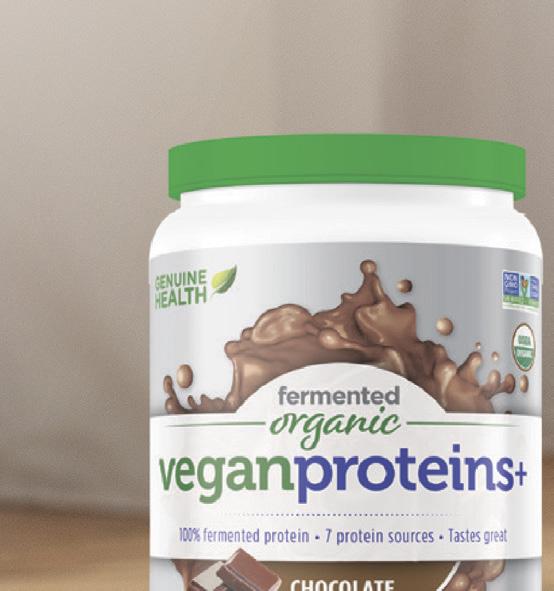
Easy to DIGEST & ABSORB







genu i nehe a l t h.co m PROUDLY CANADIAN
• Essential vitamins formulated and packaged in Canada

• Every ingredient tested for quality, purity, and e cacy
• Non-GMO – never any pesticides, fungicides, herbicides, or solvents
• Carbon-neutral and committed to sustainable manufacturing
30




























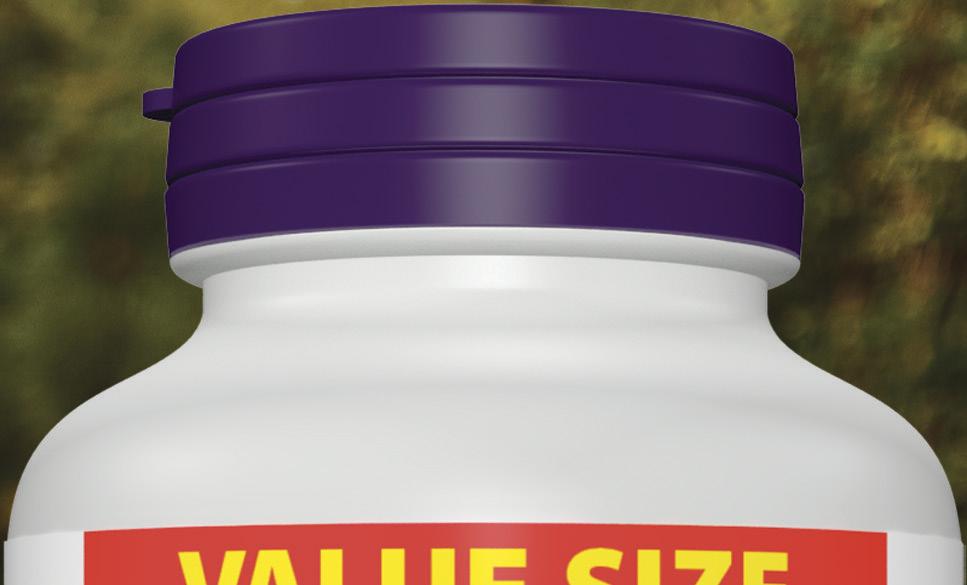

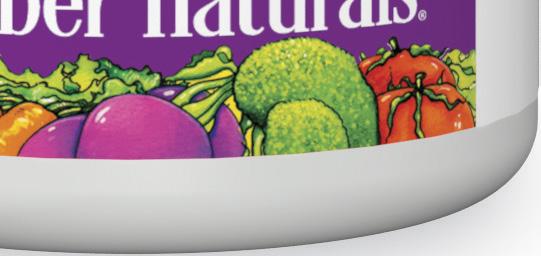


























31 Pick up a bottle today at your favourite pharmacy or grocery store! webbernaturals.com The ABCs of Good Health

32
Be a fitness role model for your CHILDREN’S FUTURE HEALTH
How to inspire your family to exercise
STRONG KIDS, STRONGER FUTURE: WHY EXERCISE MATTERS
Regular physical activity supports your child’s healthy development and reduces the risk of obesity, childhood diabetes, and other health concerns. But the benefits run even deeper.
“Helping kids move their bodies prepares their minds and behaviours for greatness,” says Brooke Cavalla, a personal trainer and mother of three. “Exercise improves the way the brain functions, which gives kids a better ability to learn.”
In one study, children who started exercising saw their academic performance increase by 6 percent, while sedentary children saw their grades drop over time.
Exercise byproducts
Aside from improving your child’s academic outcomes, regular physical activity also
• improves mental health
• boosts confidence and self-esteem
• reduces stress and anxiety (a fast-growing problem in youth)
And what your child does today affects their future. Studies have found that kids who exercise grow up to be adults who exercise.
“Children who learn healthy behaviours and the importance of fitness are more likely to continue making healthy lifestyle choices [as they get older],” says physical therapist Chanha Hwang, who coaches dads to become healthy role models for their children. “A healthy childhood is the foundation for a healthy adulthood.”
Many kids find it challenging to hit the recommended amount of daily exercise. Overcommitted schedules and lack of free time are often to blame, as well as a child’s lack of confidence in their physical abilities.
Whatever the underlying causes, fitness role models can inspire kids into action. But we’re not just talking about your child’s sports heroes. As a parent or caregiver, you have the most influence on how your family perceives exercise and wellness.
33
Exercise—it’s not just for adults! Regular physical activity offers a world of benefits for children, but three out of five Canadian kids and teens don’t get enough exercise. Become a fitness role model and inspire your entire family to get their sweat on.
Helping kids move their bodies prepares their minds and behaviours for greatness.
A family affair
“Being active with your children benefits both the child and the parent,” explains Mona Pretorius de Lacey, a Commonwealth Games medallist who has trained youth athletes for more than 15 years.
You’ll be more motivated
Exercising together creates extra motivation and accountability for parents. You’ll push yourself just knowing that your kids are watching, and your kids will call you out if you don’t follow through with your workout commitments.
You’ll bond
“It’s a great way to bond with your children with a fun activity they look forward to doing with you,” says de Lacey.
You’ll get a chance to talk about what matters in life
Dane Miller, an Olympic athlete trainer and father of four, says fitness is a great communication channel to talk about personal responsibility, goal setting, learning to lose, and other important character traits.
Movement for kids young and old
The amount of daily exercise your child needs depends on his or her age.
infants
at least 30 minutes of tummy time and floor-based play
toddlers
180 minutes of physical activity
3 to 4 years
180 minutes of physical activity, at least 60 minutes of very energetic play
5 to 17 years
1 hour of moderate or vigorous physical activity, plus 3 days a week of age-appropriate muscle-strengthening exercises
Hydration for kids
Staying hydrated boosts your child’s health and improves cognitive performance.
How much?
AGE + DAILY AMOUNTS
infants over 6 months
4 to 8 oz (120 to 240mL) (above and beyond breastmilk or formula)
toddlers 4 cups (1 L)
4 to 8 years 5 cups (1.2 L)
older children
7 to 8 cups at least (1.65 to 1.9 L)
(may vary by individual and activity/environmental conditions)
What type?
Water is ideal. Limit sugary drinks, including juice.
How to encourage more hydration?
If your child struggles to drink enough water, try
• using an extra-special cup or water bottle (you could even let them decorate it)
• offering hydrating snacks, such as cucumber slices or celery sticks
• making “magic” ice cubes with fruit or berries frozen inside
34
HOW TO BE A BETTER FITNESS ROLE MODEL
1. Lead by example
“One of the best ways parents can encourage their kids to exercise is to stay active themselves,” says Cavalla. “Kids learn more by what we do than what we say. My kids have been watching me exercise since they were born. And to this day, they love jumping into my workouts and trying to do the exercises I am doing.”
Like Cavalla, invite your children into your personal fitness journey
• Share your excitement about exercise and what it does for you.
• Find ways to have your kids join in or cheer along.
• Show them that it’s not always easy, but it’s always worth it.
2. Focus on emotional and mental benefits
Be cautious about inspiring children with a big sports win or a specific physical outcome. “When exercise doesn’t meet those expectations, kids quit,” warns youth fitness specialist Jeanette DePatie. “It’s much better to focus kids on other benefits, like how good they feel and how much fun they have.”
Positive language matters
“I never use the words ‘fat’ or ‘lose weight’ with kids,” says certified personal trainer Helen Ryan. “There should be no shame in your fitness game. Shaming kids into exercise doesn’t work in the short term and can put them off fitness in the long term.”
3. Let children choose their own adventure
Every kid has his or her own fitness personality. You might have an ultra-competitive child who thrives on team sports. Or you might have a child who enjoys time in nature and solo free play.

Find the “just-right” fitness groove
“Help them find something they like,” says DePatie. “Childhood is a great time for them to try different kinds of fitness. Get them to find their own fitness groove.”
4. Focus on play and movement, not on “exercise”
All kids love to play. “Keep it fun,” suggests parenting expert and Ironman triathlete Katey Collins, LCSW. “Incorporate games, adventures, walks, new challenges, and time with friends.”
Kids don’t necessarily need a “real” workout in a gym
• Play a game of fetch with the family dog.
• Walk or bike to the playground instead of driving.
• Set up an obstacle course in your backyard.
• Play tag with friends.
“Offer a variety of options,” says Collins. Mix it up with team sports, hobbies, family games, etc. “Give them different experiences, and notice which ones make them happy. If they’re laughing and don’t want to leave, continue encouraging participation in that activity. We all have different interests and strengths!”
35
Green skin care

How green beauty is making its mark and why you should make the switch
Companies are upping the ante when it comes to green beauty products, in both selection and quality. Now is the time to nourish your skin with toxin-free and environmentally friendly masks, restorative under-eye oils, mascara, foundation, hair dye, and more.
36
A NATURAL BEAUTY PRODUCT REVOLUTION
Cris Robinson, co-owner of Purple Carrot Health Foods & Wellness in Lethbridge, Alberta, remembers the early years of natural skin care—about 15 years ago. Back then, options for natural products were hard to find. For instance, “the only eyeliner available felt like you were drawing with a pencil crayon on your face,” says Robinson.
Since then, she says, there has been a revolution in variety and quality of natural beauty products, including advances in sustainable packaging.
Four years ago, Robinson opened the Purple Carrot, a refillery, health food, supplement, and local product store, alongside her co-owner, Cathy Lancaster. Before that, Robinson was a nutritional consultant, who had to send her clients running around the city for the natural products she suggested. They opened Purple Carrot to offer a one-stop natural shop.
Robinson invites you to think carefully about your skincare product choices. “We’re bombarded with junk all the time in the various products we use, such as cleaning products. When we can make the choice, we should,” says Robinson.

PERKS OF GOING GREEN
Lindsay Coulter, green living expert as David Suzuki’s Queen of Green for over a decade, who continues to share her insights through @saneaction, says there are other benefits to going green in the beauty aisle.
For one, natural products are pure, and often multipurpose. For instance, you can use rosehip oil to moisturize and cleanse, for osteoarthritis relief, and as aromatherapy for stress reduction. The ingredients also won’t strain the environment when you wash them off.
What’s more: Some new products, including shampoo and conditioning bars, dispense with the packaging altogether. Going green for your beauty and skin doesn’t have to be an expensive endeavour either, says Coulter. DIY options could help keep your costs down.
Lane Edwards, founder of Edmonton-based Pura Botanicals, also advocates for the benefits of going green and natural.
Natural beauty ingredients
Green on the go
DON’T LET TRAVEL THROW YOU OFF COURSE. PACK THESE SIX ESSENTIALS TO ENSURE YOU STAY ON THE NATURAL PATH, EVEN WHEN YOU’RE ON-THE-GO.
1. Coconut oil in a jar. This multipvurpose beauty tonic can be used for shaving, as a moisturizer, to tame frizzy locks, and soothe dry lips. Plus, the jar comes in handy as a reusable cup/container once you’re out of oil.
2. Castile bar soap. Great for face, hair, and body, this non-toxic soap is a multipurpose space-saver. Don’t forget a tin to store it in.
3. Natural hand sanitizer. Keep a small bottle of natural sanitizer on hand, or wipes, to clean sticky fingers and tray tables. (Remember that sanitizers must contain at least 60% alcohol to sanitize.)
4. Mineral sunscreen. Look for those containing titanium dioxide or zinc oxide.
5. Essential oil insect repellent. Citronella, peppermint, and thyme are thought to keep insects at bay. After applying a test patch, add diluted oils to moisturizers or spray bottles filled with water for easy application.
Antioxidants—such as herbal extracts, coenzyme Q10, and green tea—are now used for high quality natural skin care.
6. Sugar-free gum. This is the perfect travel companion for bad breath and altitude changes. Opt for gum that’s naturally sweetened with xylitol, for example. (Bonus: xylitol is plant-based too.)

37
Many natural products have shown effectiveness through clinical research.
What do these certifications mean?
The budding frontier of cannabis in skin care
LEAPING BUNNY
Products using this logo have certified to the Coalition for Consumer Information on Cosmetics (a consortium of eight animal protection groups) that “they do not conduct or commission animal tests, and do not use any ingredient or formulation that is tested on animals.”


PETA
People for the Ethical Treatment of Animals also certifies companies who pledge that “they and their suppliers do not conduct, commission, or pay for, or allow any tests on animals for their ingredients, formulations, or finished products anywhere in the world …”
CERTCLEAN

The CertClean certification means the product is “free from ingredients that may pose risk to our hormonal, reproductive, and/or neurological systems, like talcum powder, formaldehyde-releasing preservatives, parabens, sodium lauryl sulfates, and hundreds more …”

Cannabidiol (CBD) is a nonpsychoactive compound extracted from the cannabis plant. CBD is used in a myriad of beauty products, such as soaps, tissue repair serum, lotions, and lip balms. The global CBD skincare market is expected to reach US$1.7 billion by 2025.
Along with antiaging benefits, preliminary studies have found potential benefits of CBD in the treatment of acne, atopic dermatitis, psoriasis, skin cancer, and fibrotic skin diseases.
In a 2018 study published in the Journal of Drugs in Dermatology, 86 percent of dermatologists surveyed believed that cannabinoids have medical benefits beyond treating pain and nausea. But, at this early stage, some are advising caution. The American Academy of Dermatology says we still need to know more about proper dosages, how CBD interacts with other medications, and the possible side effects of applying CBD to the skin.
INFUSED WITH EMPOWERMENT AND SELF-LOVE
Edwards was inspired to found Pura when, while pregnant with her first child, she became sensitive to conventional beauty products. She created her own line of plant-based, eco-friendly, nontoxic, and synthetic-free products, infused with a strong culture of empowerment and self-love.
Edwards uses essential oils in many of her products. “They really amplify a formula if done in a conscious way and in small doses,” explains Edwards. Essential oils are often used to uplift mind, body, and spirit. Although research is not definitive on its role in some areas of health and well-being, some studies show that aromatherapy may help improve mood, decrease anxiety, assist with sleep, and ease pain.
Edwards, who views Health Canada certification as an intense process, but essential, also certifies her products through Leaping Bunny, PETA, and CertClean.
STAYING SAFE IN THE SUN
When you’re choosing a sunscreen, scan the active ingredients on the label. Titanium dioxide and zinc oxide are considered safe and natural sunscreen ingredients. One caveat, though: even if these natural ingredients are the only ones listed, the nonactive ingredients could be synthetic and potentially harmful to your health or the health of the environment.
Coulter suggests checking the Environmental Working Group’s Skin Deep database (ewg.org/skindeep) to see how your sunscreen—and other products—stacks up.
38
• Helps support gastrointestinal health






















• Restores and normalizes intestinal flora











































•



















Vegetarian-friendly formulas











Pick up a bottle today and feel the di erence!



Help Your Gut Flora Flourish!
com
summer Red hot
Chili-infused recipes to kick up your health

VEGETARIAN
A papaya salad from a Thailand street market or a fragrant curry dished out by a family restaurant in southern India wouldn’t be the same without their chili punch. Just imagine eating street tacos in Mexico if they didn’t induce a few drops of sweat. What we typically eat in North America is relatively tame in comparison.
You don’t have to be a heat freak to enjoy eating chili peppers since their “spice” levels vary greatly—enough to suit all tastes. Beyond their culinary virtues, research suggests that hot peppers may literally be the “spice of life” by improving the chances for healthy longevity.
Grab a glass of milk and settle in—it’s time to bring the heat into the kitchen.
Minty Chili Pea Soup
This brightly coloured soup for chili lovers is the perfect way to welcome back warmer weather. Looking for a little less heat? Substituting serrano pepper with jalapeno will make a slightly less spicy soup. Garnish options include pea shoots, hemp seeds, sesame seeds, sliced roasted almonds, chives, or a swirl of sour cream.
Paging Dr. Pepper
SERVES
Ingredients
1 Tbsp (15 mL) grapeseed oil or sunflower oil
1 leek, white and light green part, thinly sliced
1/2 tsp (2 mL) salt
1/2 lb (225 g) new potatoes, quartered
2 garlic cloves, chopped
2 serrano chili peppers, or jalapenos, seeded and chopped
3/4 tsp (4 mL) ground coriander
1/2 tsp (2 mL) black pepper
4 cups (1 L) low-sodium vegetable broth
3 cups (750 mL) fresh shelled or frozen peas
1 cup (250 mL) fresh mint
Juice of 1/2 lemon
In large saucepan, heat oil over medium heat. Add leek and salt; cook until softened, about 5 minutes, stirring regularly. Add potatoes and garlic; heat for 3 minutes. Add serrano pepper, coriander, and black pepper; heat for 1 minute.
Add broth to pan. Bring to a boil and simmer over medium-low, covered, until potato is tender, about 15 minutes. Add peas and continue heating until they are tender, about 5 minutes. Stir in mint and lemon juice. Using blender or food processor, purée soup in batches if necessary. Thin with additional broth or water, if needed. Ladle into each of 4 bowls.
For flaming hot health, go ahead and turn up the heat. A recent study from the American Heart Association found that people who eat chili peppers regularly may be 26 percent less likely to die of heart disease and 23 percent less likely to die of cancer than those who don’t. While this investigation can’t prove cause and effect, nor did it nail down how many or which chili peppers lower the risk the most, it’s believed that capsaicin—the compound that gives chilies their fiery kick—can be good for our health by reducing inflammation and even bolstering metabolism. More research is needed, but if you like to spike your meals with chili peppers, you may reap some health and longevity rewards for doing so regularly.
BLEND MASTER
If you find yourself making many batches of puréed soups, consider investing in an immersion blender. This handy tool lets you blend soups in the pot they’re made in to help streamline prep.
EACH SERVING CONTAINS: 185 calories; 7 g protein; 4 g total fat (0 g sat. fat); 31 g total carbohydrates (8 g sugars, 8 g fibre); 447 mg sodium
41
4
If you’ve spent any time travelling around the globe, your burning lips have made you well aware of the way various guises of chili peppers have become a fixture of so many world cuisines.
BELL
0 SHU sweet with no detectable heat
BANANA
0 to 500 SHU tangy with very mild heat
CHERRY/PIMENTO
100 to 500 SHU sweet and mild
PIMENTO
100 to 500 SHU sweet with very little heat
CUBANELLE
100 to 1,000 SHU sweet and mild to slightly hot
POBLANO
1,000 to 1,500 SHU mild heat
ANAHEIM
500 to 2,500 SHU mild to slight heat
JALAPENO
2,500 to 8,000 SHU mildly hot to medium hot
FRESNO
2,500 to 10,000 SHU mildly hot to medium hot
SERRANO
10,000 to 23,000 SHU hot
CAYENNE
30,000 to 50,000 SHU medium hot to hot
THAI/BIRD’S-EYE
50,000 to 100,000 SHU very hot
PERI PERI/AFRICAN BIRD’S-EYE
50,000 to 100,000 SHU very hot
HABANERO
100,000 to 350,000 SHU scorching hot
SCOTCH BONNET
100,000 to 350,000 SHU scorching hot
Hurts so good
Capsaicin content of peppers is measured in Scoville heat units (SHU), a system invented by chemist Wilbur Scoville in the early 1900s. He determined that neutralizing one drop of jalapeno capsaicin extract requires about 5,000 drops of sugar water, hence jalapeno’s rating of 5,000 SHU. Pure capsaicin clocks in at 16 million SHU.

It should be noted, however, that the same types of pepper could have different capsaicin levels, depending on factors including growing conditions. So one serrano pepper might be rather tame while another one will knock your socks off.
For the most part, you can keep shape in mind to control the heat level in your dishes: hotter peppers are often narrow with pointy ends (habanero and scotch bonnet being exceptions), while milder peppers tend to have broad shoulders and blunt tips.
If you’re easing into the world of chili peppers, it’s a good idea to start with peppers that rank on the lower end of the SHU scale and then work up from there, so you may start with jalapeno pepper in your salsa before daring to try a habanero. From sweet to blazing and everything in between, here’s how the common fresh peppers rank on the pain-o-meter.
Dynamic duo
Heat intensifies the flavour of sweet ingredients, while sugars tend to tame “spicy” ingredients and highlight their fruity notes. This is why delicious results always come when you spike chocolate cake or pudding with a hit of chili pepper.
Cream of the crop
In general, select peppers that are firm, have vibrant, shiny skin, and feel heavy for their size. Try to avoid peppers that are limp or shrivelled and have soft spots or bruises. When the good ones are brought home, they should last in your fridge when stored in a paper or cloth bag for at least two weeks.
42
Sweet Potato Black Bean Dip with Pickled Jalapenos

A good option for both backyard barbecues and healthy snacking, this creamy dip benefits from a little spicy crunch, courtesy of quick-pickled peppers. If you want your dip to have a smoky edge, blend in a chipotle-flavoured salsa. Or forgo the salsa and, instead, blend in a couple tablespoons of tomato paste and a single canned chipotle chili pepper. Extras of the pickled peppers are an exciting topping for burgers, sandwiches, and tacos.
Ingredients
Pickled jalapenos
5 jalapeno peppers, stemmed and sliced into thin rounds
1 garlic clove, smashed
1/3 cup (80 mL) roughly chopped dill
1 tsp (5 mL) yellow mustard seeds
3/4 cup (180 mL) apple cider vinegar
1 Tbsp (15 mL) sugar
1 tsp (5 mL) kosher salt
Salsa
1 cup (250 mL) peeled and cooked sweet potato
2 cups (500 mL) cooked or canned black beans
1/2 cup (125 mL) jarred salsa of choice
1 garlic clove, minced
Juice of 1/2 lime
1/2 tsp (2 mL) ground cumin
1/4 tsp (1 mL) salt
To make pickled peppers, in glass jar, place jalapeno slices, garlic, dill, and mustard seeds, making sure there is at least 1 in (2.5 cm) headroom at the top. In small saucepan, bring vinegar, 1/3 cup (80 mL) water, sugar, and salt to a slight simmer to dissolve sugar and salt. Pour vinegar mixture into jar, making sure contents are completely submerged. Let cool to room temperature, seal shut, and chill for at least 6 hours and up to 1 month.
To make salsa, in food processor container, place sweet potato, black beans, salsa, garlic, lime juice, cumin, and salt, and blend until smooth.
To serve, place dip in bowl and scatter on desired amount of pickled jalapeno slices.
EACH SERVING CONTAINS: 110 calories; 5 g protein; 0 g total fat (0 g sat. fat); 21 g total carbohydrates (3 g sugars, 6 g fibre); 278 mg sodium
HOT TIP
When using prepared chili pepper products such as bottled salsas, examine the ingredient list for items you really don’t want or need, namely sugar and high amounts of sodium.
43
6 SERVES
VEGETARIAN
JALAPENOS IN DISGUISE
Chipotle chiles are dried, smoked jalapenos. Adobo is a slightly sweet red sauce. Put them together in a can and they become a versatile pantry staple to add deep smoky heat to sauces, dips, marinades, and soups.
Waffled Chicken
Quesadillas with Chipotle Pepper Sauce

These whimsical weeknight quesadillas offer a great excuse to break out the long-forgotten waffle iron. The smoky, tangy pepper sauce is the perfect sidekick for this dish, but it’s also wonderful when tossed with pasta, stuffed into sandwiches, and slathered on burgers. Pro tip: When assembling, keep fillings centred 1/2 in (1.25 cm) from the edge of the tortilla so they don’t spill over.
Ingredients
1/2 cup (125 mL) sour cream
1/2 cup (125 mL) roasted red pepper
1 chipotle pepper in adobo sauce
1 garlic clove, chopped
1/4 tsp (1 mL) salt
8 - 7 in (18 cm) whole wheat or corn tortillas
1 lb (450 g) cooked and sliced chicken
1 cup (250 mL) shredded cheddar cheese
2 Roma (plum) tomatoes, seeded and diced
1 cup (250 mL) sliced red onion
1/2 cup (125 mL) cilantro
1 avocado, sliced
Lime wedges
In blender container, place sour cream, roasted red pepper, chipotle pepper, garlic, and salt, and blend until smooth.
Lightly grease waffle iron and preheat to high. Place 1 tortilla on waffle iron. Top with one-quarter of the chicken, cheese, tomato, onion, and cilantro. Place a second tortilla over filling, and close waffle iron. Cook until tortilla is golden brown and cheese is melted, about 3 minutes, continuing to press down on waffle iron if needed during cooking to flatten further.
Remove quesadilla from waffle iron; repeat 3 times with remaining tortillas and stuffing ingredients. Cut into wedges and serve with pepper sauce and sliced avocado. Serve with lime wedges.
EACH SERVING CONTAINS: 508 calories; 39 g protein; 25 g total fat (10 g sat. fat); 36 g total carbohydrates (4 g sugars, 8 g fibre); 462 mg sodium
44
4 SERVES
ANIMAL PROTEIN
Salmon Burgers with Mango-Thai Salsa

These Asian-inspired salmon burgers won’t leave you missing the beef or the bun. And keep this fruity and fiery salsa in mind the next time you want to jazz up grilled chicken or taco night. Serrano pepper would be a good swap for bird’s eye pepper in the salsa—though feel free to get creative with what you can find! You can even mix some Sriracha sauce into the burgers to further punch up the meal.
Ingredients
1 lb (450 g) skinless salmon
1 large egg
1/2 cup (125 mL) panko bread crumbs
2 garlic cloves, minced
1 Tbsp (15 mL) low-sodium soy sauce or tamari
1/3 cup (80 mL) basil
Zest of 1 lime
Juice of 1/2 lime
2 tsp (10 mL) fish sauce
1 tsp (5 mL) sesame oil
1 tsp (5 mL) coconut sugar, or sweetener of choice
1 1/2 cups (350 mL) halved cherry tomatoes
1 cup (250 mL) cubed mango
2 green onions, sliced
1 bird’s eye chili pepper, or other hot chili, minced
1/3 cup (80 mL) chopped cilantro
1 Tbsp (15 mL) peanut oil or grapeseed oil
In food processor container, place salmon, egg, bread crumbs, garlic, soy sauce, basil, and lime zest, and pulse several times until you have a chunky mixture. Form into 4 patties.
In large bowl, whisk together lime juice, fish sauce, sesame oil, and sugar. Stir in tomatoes, mango, green onions, chili pepper, and cilantro.
In large skillet over medium-high, heat oil. Place salmon burgers in skillet and cook for 3 minutes on each side, or until crispy on the outside but just barely cooked through in middle, to an internal temperature of 145 F (63 C). Alternatively, you can prepare the burgers on an outdoor grill over medium heat, making sure grill grates are well greased.
Serve salmon burgers topped with salsa.
EACH SERVING CONTAINS: 345 calories; 26 g protein; 19 g total fat (3 g sat. fat); 18 g total carbohydrates (9 g sugars, 2 g fibre); 474 mg sodium
SKINLESS, PLEASE!
Skinless fish is the only way to go for burgers. Don’t be afraid to ask! A helpful fishmonger will kindly skin fillets for you before purchase. As an alternative to salmon, you can also blend up skinless fillets of arctic char or rainbow trout.
SEAFOOD PROTEIN 4 SERVES
45

Fire it up!
We’re taking advantage of every excuse to get outside with this collection of delicious recipes perfectly suited for the grill. We’ve jazzed up the BBQ with some gutsy flavours, coupled with options to satisfy the vegetarian and vegan in the crowd. Plus, we’ve provided a few hints for pairing the best-flavoured suds with your meal.
The best eats for grillin' and chillin' under the summer sun
In large bowl, combine ground beef, garlic, gingerroot, and pepper. Mix with a fork or your hands to blend. Do not overwork meat or your patties will become tough when grilled. Divide mixture into 4 even-sized patties, about 1/2 in (1.25 cm) thick. Place on plate and refrigerate. Grease barbecue grate and preheat grill to about 425 F (220 C).
In small bowl, combine mayonnaise, chili garlic sauce, and lime juice. Stir to blend. Set aside.
Place patties on preheated barbecue; grill for at least 3 minutes per side, flipping once, until meat thermometer inserted in thickest portion registers 160 F (70 C) in centre. Remove from heat to clean, warmed plate and cover to keep warm. Burgers will continue to cook as they rest.
Bánh Mi Burgers with a Kick
ANIMAL
4 SERVES
Typical of Vietnamese fare, bánh mi is a familiar Saigon submarine-type sandwich often sold by street vendors. It’s a soft bun loaded with pickled veggies and shaved cucumber piled high onto grilled meat. We jazzed up our version with spicy kimchi and plenty of fresh crisp cucumber to balance it out.
Ingredients
1 lb (450 g) lean, organic, grass-fed ground beef
1 tsp (5 mL) finely minced garlic
1 tsp (5 mL) peeled and grated gingerroot
1/2 tsp (2 mL) freshly ground black pepper
1/4 cup (60 mL) low-fat mayonnaise
2 tsp (10 mL) commercially prepared chili garlic sauce
1 tsp (5 mL) fresh lime juice
3/4 cup (180 mL) commercially prepared spicy kimchi, well drained and finely chopped
1/2 unpeeled English cucumber, thinly shaved into rounds
4 crusty whole wheat or brioche hamburger buns, split
8 leafy lettuce leaves
1/2 cup (125 mL) fresh cilantro leaves
Garnishes of choice: sliced pickles, tomatoes, sprouts, sweet onion, and/or jalapeno peppers
Lightly spread cut sides of buns with some mayonnaise mixture. Place cut side down on grill and lightly toast.
To assemble, divide remaining mayonnaise mixture evenly among bottom halves of toasted buns. Top each with a couple of lettuce leaves. Place one patty on each. Top with equal amounts kimchi, shaved cucumber, and cilantro leaves. Add additional garnishes if you wish. Cover with top bun halves and serve.
VEGETARIAN OPTION
For a vegetarian burger, substitute grilled tempeh patties for the ground beef and opt for vegan mayonnaise.
Bestbeer?
Put your buds on fire with this fusion sandwich and then chill them out with a cool IPA.
EACH SERVING CONTAINS: 481 calories; 37 g protein; 21 g total fat (7 g sat. fat); 34 g total carbohydrates (7 g sugars, 6 g fibre); 695 mg sodium
47
PROTEIN
Grilled New Potatoes
and Lentils with Creamy Lemon Dressing
Early summer potatoes, cooked and grilled, are just the ticket for this fabulous salad. Coupled with lentils, they’re a delicious add-on to any meal plan. This recipe offers an added bonus: it can be made in stages, so you’re not cooking all afternoon.
Ingredients
Lentils
1 Tbsp (15 mL) extra-virgin olive oil
1 small carrot, peeled and finely diced
1 celery stalk, finely diced
1 small onion, finely diced
1 generous fresh thyme sprig
1 bay leaf
1/2 tsp (2 mL) sea salt
1/2 cup (125 mL) dried French lentils
2 cups (500 mL) water
Potatoes and creamy lemon dressing
1 1/2 lbs (750 g) new potatoes, such as fingerlings or young Yukon Gold or red potatoes
1 cup (250 mL) low-sodium chicken broth
1/2 cup (125 mL) buttermilk
2 Tbsp (30 mL) grainy Dijon mustard
2 Tbsp (30 mL) lemon juice
1 tsp (5 mL) liquid honey
1/2 tsp (2 mL) sea salt
1/2 tsp (2 mL) freshly ground black pepper
2 Tbsp (30 mL) extra-virgin olive oil
3 green onions, thinly sliced
1/4 cup (60 mL) chopped fresh parsley
1/2 cup (125 mL) microgreens or radish sprouts
2 oz (57 g) shaved prosciutto, torn into bite-sized pieces (optional)
In medium-sized saucepan, heat oil. Add carrot, celery, and onion, and sauté over medium heat just until onion is soft, about 3 minutes. Add thyme sprig, bay leaf, salt, lentils, and water and bring to a boil. Cover and simmer over medium-low heat for about 18 to 20 minutes, or until lentils are almost tender but still hold their shape and have a bit of bite to them. Drain well and turn out onto baking sheet to cool. Remove thyme stems and bay leaf and discard. Lentils can be made ahead and stored in a closed container for up to 3 days, if you wish.
Cut potatoes in half. In large saucepan, place potatoes and add enough water to cover by 1 in (2.5 cm). Add a dash of salt, if you wish. Boil gently for 15 minutes or until tender but still firm. Remove. Drain and place in large bowl. Stir broth into bowl with cooked potatoes and set aside. Potatoes will absorb broth; they can be refrigerated in broth overnight if you wish.
In small bowl, combine buttermilk, Dijon, lemon juice, honey, salt, and pepper. Vigorously whisk to blend. Add more seasonings, to taste. Dressing can be made ahead and refrigerated in airtight container for a couple of days.
When ready to serve, grease barbecue grate and preheat to 425 F (220 C). Drain any remaining broth from cooked potatoes. Drizzle potatoes with oil and gently toss to coat. Grill potatoes until golden, about 5 to 7 minutes. Turn occasionally. Transfer to large bowl. Add cooked lentils and drizzle with buttermilk dressing. Gently toss to evenly coat. Spoon onto serving platter and scatter with chopped green onions, parsley, and microgreens. Tuck prosciutto in and around, if using. Serve at room temperature, or refrigerate for a couple of hours and serve cold.
VARIETY IS THE SPICE OF POTATO-SALAD LIFE
Potato salad lends itself to any number of variations, and this recipe doesn’t disappoint. Try swapping out microgreens for baby spinach leaves. Another interesting slant: crisp up (optional) prosciutto on the grill before breaking into bite-sized pieces and scattering over the salad.
Bestbeer?
You can’t go wrong serving this dreamy salad with a simple and uncomplicated pale ale.
EACH OF 6 SERVINGS CONTAINS : 184 calories; 5 g protein; 7 g total fat (1 g sat. fat); 26 g total carbohydrates (4 g sugars, 5 g fibre); 398 mg sodium
48
4
6 SERVES VEGETARIAN
-

Easy tips for creating the perfect burger
It’s easy to take cooking a perfect burger for granted; people have been flipping them for years. But using the following tips will provide a benchmark to achieving the best possible results:
For perfect burgers, use ground meat that’s about 85 percent lean.
Refrigerate raw patties before cooking to keep them intact during grilling.
Don’t overhandle meat to avoid toughening it up during grilling.
Press thumb into centre of each patty, forming a dent before grilling, to keep burger in shape and ensure even cooking.
Avoid pressing burgers down with a spatula during grilling; you’ll squeeze out the delicious juices!
Try to flip burgers only once to keep them tender and juicy.
Always test with a meat thermometer to assure doneness.
Allow patties to rest for about 5 minutes after grilling.
Quaffable beer tips
These days beer comes in a dizzying selection of flavours, in an equally diverse array of cans and bottles that bear labels with amazingly creative artwork. From large producers to microbreweries, there’s a flavoured beer to appeal to almost anyone. For our recipes, we’ve provided our best recommendations based on the recipes, although there’s never just one truly perfect match. Here’s a layperson’s guide to flavours in a widely diverse selection. Let your own beer bias prevail!
IPA stands for India pale ale and is understood to be one of the first brews of the “craft” beer movement. There are many flavours in the IPA grouping, ranging from citrus high notes to hoppy and bitter overtones. Given the immense variety, a flight of IPAs covering a citrus note, hoppy tone, and herbal flavour would be the best way to cover all ranges of taste buds.
LAGER is mild and easy to quaff for the beginner in the crowd. It’s a great bevvy for any grilled or chilled recipe. A honey-flavoured lager is an especially easy sipper. Pilsners fall into this grouping.
PALE ALE , not to be confused with India pale ale, is blonde in colour and has light alcohol content with a hit of malt.
STOUT is a dark and heavier brew stemming from unfermented sugars. Typically sweet overtones, roasted, and somewhat creamy on the tongue. Some brews come with hints of espresso and dark chocolate.
PORTER is much like stout but with a greater suggestion of chocolate overtones.
BELGIAN beers cover the gamut from light to dark and hoppy to citrusy with an enhanced alcohol content.
WHEAT BEER like the grain, is light in colour and in alcohol content—perfect for a summer day.
SOUR BEER is, as it’s called, “sour” as well as tart—perfect for someone with super discerning taste buds.
Everything-But-Meat Salad
If there’s a vegan or vegetarian in the crowd, then this dish will be sure to please. Chock full of complementary textures and flavours, it not only qualifies as eye candy, but is also a substantial stand-alone meal—a stunning meal in a dish!
Ingredients
2 cups (500 mL) packed kale, washed, spun dry, and torn into bite-sized pieces
1 Tbsp + 1/4 cup (15 mL + 60 mL) extra-virgin olive oil, divided
1 head Romaine, washed, spun dry, and shredded
1/2 head radicchio, shaved
4 large curly endive leaves, washed, spun dry, and torn into bite-sized pieces
1/2 unpeeled cucumber, cut into matchstick pieces
1 large carrot, peeled and grated
1 cup (250 mL) grape tomatoes, halved
4 large radishes, shaved
1 crisp, green unpeeled apple, cored and thinly sliced
1/4 small, sweet onion, shaved into rounds
2 Tbsp (30 mL) seasoned rice vinegar
2 tsp (10 mL) Dijon mustard
1 tsp (5 mL) maple syrup
1/2 tsp (2 mL) sea salt
1/4 tsp (1 mL) freshly ground black pepper
1/2 cup (125 mL) toasted nuts such as walnuts or hazelnuts, chopped, or pumpkin seeds
1/4 cup (60 mL) hemp hearts
Bestbeer?
Serve this salad with an IPA or pale ale. For a more adventurous sip, it’s equally delicious with a Belgian pale or dark ale.
In large bowl, place kale and drizzle with 1 Tbsp (15 mL) oil; using your fingertips, rub oil into leaves to soften. Add Romaine, radicchio, endive, cucumber, carrot, tomatoes, radishes, apple slices, and sweet onion, separated into rings. In small bowl, combine vinegar, mustard, syrup, salt, and pepper. Whisk to blend. Gradually whisk in 1/4 cup (60 mL) oil until emulsified. Drizzle over salad and gently toss to coat. Top salad with nuts and hemp hearts.
EACH SERVING OF 6 CONTAINS: 265 calories; 6 g protein; 21 g total fat (3 g sat. fat); 16 g total carbohydrates (9 g sugars, 5 g fibre); 339 mg sodium

51 6 SERVES VEGETARIAN
FROM CAKE TO COOKIES
We made this delicious dessert into a cake, but it can easily be made into individual ice cream cookies. Roll out dough into 1/4 in (6 mm) thickness and cut into 2 in (5 cm) rounds. Bake, cool, and chill. Once chilled, spoon ice cream in between chilled cookies. Freeze until firm. Drizzle with melted chocolate or dip into melted chocolate.

Bestbeer?
Extra yum when served with small glasses of chocolate-flavoured stout or porter.
GF Almond Tahini Ice Cream Cookie Cake
Ice cream cakes and/or cookies are everyone’s favourite. And here’s a great option for a delicious cookie cake that’s gluten free! A simple-to-make treat that’s made even easier when the dough is tossed together in a food processor. End a delicious outdoor feast with this cool and creamy sweet dessert.
Ingredients
2 1/2 cups (625 mL) gently packed ground almonds, preferably raw almonds
6 pitted dates
3 Tbsp (45 mL) blonde tahini
2 Tbsp (30 mL) maple syrup
1 Tbsp (15 mL) miso paste
2 Tbsp (30 mL) buckwheat flour (optional)
2 cups (500 mL) prepared vanilla ice cream or frozen dairy alternative
1 oz (28 g) dark chocolate, melted
Preheat oven to 350 F (180 C). Lightly grease two 8 in (10 cm) round cake pans and line bottoms and sides with greased parchment paper.
In food processor, place ground almonds, dates, tahini, syrup, and miso paste, and pulse until it all comes together. Add buckwheat (or other type of gluten-free flour) if mixture is too moist. Mixture should be crumbly but able to stick together when pinched with your fingertips.
Divide mixture among prepared pans. Press with your fingertips into evenly packed crust right to edges. Bake in oven for 10 to 12 minutes until dough is almost firm when touched. Remove pans to rack to cool completely.
Soften ice cream just enough to be spreadable. Spoon on top of one of the chilled cookie cakes and smooth out to sides in an even layer. Remove cookie from cake pan and place on top of ice cream, gently pressing down. Place in freezer overnight to completely firm up.
To serve, remove cake from freezer and turn out onto flat serving plate or wooden board. Drizzle with melted chocolate. Using warm knife, cut cake into wedges and serve immediately.
EACH SERVING CONTAINS: 268 calories; 9 g protein; 13 g total fat (3 g sat. fat); 30 g total carbohydrates (18 g sugars, 3 g fibre); 43 mg sodium
52 8
SERVES
VEGETARIAN

(888) 424-3336 Clinton, Michigan edenfoods.com cs@edenfoods.com ©2022 Eden Foods 11290 Real organic Roma and Napoli Italian Tomatoes make remarkably and uniquely delicious sauce with real organic Eden Extra Virgin Olive Oil, Vegetables, and Spices.
Leafy goodness
Diversify your diet by expanding your leafy greens portfolio

VEGETARIAN
Why greens? Nitrate-rich leafy greens are low in calories, carbohydrates, and saturated fat and can play a role in reducing your risk of heart disease. Leafy green vegetables also pack a punch with an abundance of nutrients and active ingredients, including vitamin K, lutein, folate, and beta carotene, that may lower the risk of cancers and help slow cognitive decline.
Don’t forget about herbs! Basil, mint, and parsley contain antioxidants and anti-inflammatory flavonoids as well as a range of vitamins and minerals. So, no more excuses! Get your greens with these five recipes that include substitutions for just about any leafy option.
Sorrel Soup with Leek, Potatoes, and Almond Cream
Lemony sorrel and white wine add a delicious tang to this up-styled leek and potato soup. If you can’t find sorrel, use spinach, nettle, or Swiss chard with a teaspoon of fresh lemon juice. The almond cream is optional, but it makes for a pretty presentation. Skip it if you have an allergy or low-powered blender.
SERVES
Ingredients
Almond cream (optional)
2 Tbsp (30 mL) natural almonds
3 Tbsp (45 mL) water
Sorrel soup
1 tsp (5 mL) extra-virgin olive oil
1 leek, white and light green parts only, finely chopped
1 cup (250 mL) dry white wine (optional)
4 to 5 cups (1 L to 1.25 L)
low-sodium vegetable broth (see tip)
1 bay leaf
2 cups (500 mL) potato, peeled and cut into 1/2 in (1.25 cm) cubes
1/2 cup (125 mL) fresh parsley, separated into stems and leaves
1 cup (250 mL) French sorrel
Salt and pepper, to taste
In small bowl, soak almonds in 1 cup (250 mL) water for at least 30 minutes or up to 8 hours. Drain almonds and remove skins. In blender, purée with 3 Tbsp (45 mL) water until smooth. Reserve purée, and rinse blender.
In large pot, add olive oil and sauté leek for 5 minutes, stirring frequently. Add white wine (if using) followed by broth, bay leaf, potatoes, parsley stems, and sorrel. Bring to a boil, reduce heat, and simmer for 15 minutes. Transfer to blender (or use immersion blender) and blend until smooth. Taste and add salt and pepper if desired.
To serve, divide soup among bowls and swirl 2 tsp (10 mL) almond cream into each serving. Garnish with remaining parsley leaves.
KEEP THE WINE DRY
Choose a dry wine so there’s no obvious taste of residual sugar in the soup. If you prefer not to use wine, use 5 cups (1.25 L) vegetable broth instead of 4.
EACH SERVING CONTAINS: 112 calories; 2 g protein; 2 g total fat (0 g sat. fat); 15 g total carbohydrates (3 g sugars, 3 g fibre); 105 mg sodium
55
6
We all know we should eat more leafy greens, but if you find yourself in a dark green rut (we’re looking at you, kale!), there’s a world of ways to make greens delicious—cooked or raw.
Lettuce or Collard Wraps with Thai Basil, Tempeh, and Peanut Sauce
These wraps are naturally gluten-free and can be extra crunchy, juicy, or savoury depending on your wrapper choice. If you use lettuce, choose a type with large, firm leaves that will hold the fillings well. Collard greens are sturdier and more nutritious, but you’ll want to remove the stems before rolling. Don’t let that fibre go to waste, though; dice the stems and use them for soup or stir-fries, or pickle them for salads.
Ingredients
Peanut sauce
2 Tbsp (30 mL) gluten-free soy sauce or tamari
2 Tbsp (30 mL) rice vinegar
1/4 cup (60 mL) water
1 tsp (5 mL) toasted sesame oil
1/2 in (1.25 cm) piece fresh gingerroot, grated
2 tsp (10 mL) maple syrup or organic palm sugar, to taste
1/4 cup (60 mL) unsweetened, plain peanut butter powder
(see tip)
Wraps
8 oz (225 g) pkg tempeh, cut into 1/4 x 2 in (1 x 5 cm) pieces
1 bird’s eye chili pepper, or another hot chili, thinly sliced (optional)
1 red or yellow bell pepper, julienned
1 cup (250 mL) julienned cucumber or jicama
1/2 cup (125 mL) julienned (unpeeled) apple
1/2 cup (125 mL) basil leaves, Thai or holy preferred
1/2 cup (125 mL) fresh mint leaves
1 head lettuce or 1 bunch collard greens
GO FOR THE GREENS
WHAT’S PEANUT BUTTER POWDER?
Peanut butter powder has the concentrated flavour of peanut butter without the oil. It’s convenient not only for camping trips, but also for sauces and dips. It comes in unsweetened, sweetened, and chocolate flavours. If you can’t find it, substitute regular, unsweetened peanut butter, and skip the sesame oil.
In medium pot, bring soy sauce, vinegar, water, sesame oil, ginger, and maple syrup to a boil. Remove from heat. Pour half into medium bowl and stir in peanut butter powder.
Return pot with remaining marinade to stove and add tempeh pieces. Reduce heat to medium-low, cover, and simmer for 10 minutes, turning tempeh frequently to braise evenly. Remove lid and cook until no liquid remains.
To assemble, place small amounts of tempeh and fillings in lettuce or collard leaves. Tuck in sides of leaves and roll up to seal or leave open like tacos. Serve with peanut sauce.
Collard greens and Swiss chard add calcium to your diet, which is more easily absorbed thanks to their vitamin D content. Raw lettuces, arugula, and chicory contain vitamins
A, C, E, and K (and add punch to a salad). And bok choy and other leafy Brassicaceae are high in vitamin B, especially folate, which helps keep your brain healthy.
EACH SERVING CONTAINS: 209 calories; 27 g protein; 8 g total fat (1 g sat. fat); 23 g total carbohydrates (5 g sugars, 8 g fibre); 417 mg sodium
56 4
SERVES VEGETARIAN
Fill in those (nutritional) blanks
While it’s generally better to just eat your leafy greens, there are supplements that can help. Most blend greens with grasses (think barley and alfalfa), protein (such as soy or pea), and other herbs, oils, grains, and seaweeds, so they might be more of a meal replacement than a simple supplement. Before purchasing, check for allergens, as it’s easy to miss something in the long list of ingredients.
Some products include larger varieties of leafy greens (which is what you want!), including nettle, spinach, parsley, watercress, and kale. Potential additional ingredients might include wheatgrass, alfalfa, and barley grass; green tea extract; oat bran; berries, fruits, and vegetables; stevia or maple; brown rice and seeds; and adaptogens such as astragalus and ginseng.
You can also make your own leafy greens powder by dehydrating your greens of choice and grinding them to a powder. They’re easily added to smoothies, cakes, patties, scrambled eggs, or tofu.

57
FISHING FOR ANCHOVIES
Look for anchovy paste in tubes and anchovy fillets in oil in small jars or cans in the fridge section of your fish market or grocer. In a pinch, you can substitute a can of sardines in olive oil. Just be careful when choosing a brand, as some are quite salty. The leftover paste or jarred anchovies make for a tasty addition to any kind of sautéed greens, with or without pasta.
Sautéed Rapini with Spaghetti, Garlic, Toasted Walnuts, and Anchovies

This combination of fish and walnuts is inspired by pasta dishes from Italy’s Amalfi Coast. Don’t be scared off by the anchovies. The preserved fish disappears into a rich, silken sauce infused with garlic and a hint of spice. Keeping the walnuts in large pieces adds a rich, nutty flavour and turns an economical dish into something a bit more luxurious.
Ingredients
10 oz (280 g) spaghetti
2 Tbsp (30 mL) anchovy oil (see tip)
1/2 fresh red chili pepper, finely chopped
4 garlic cloves, peeled but kept whole
1 bunch rapini, stems diced, leaves torn into small pieces
10 anchovy fillets in oil (see tip)
1/4 cup (60 mL) walnut halves
1/4 cup (60 mL) finely chopped fresh parsley
1 Tbsp (15 mL) anchovy paste (optional—see tip)
In large pot of water, cook pasta according to package directions until al dente. Drain, reserving 1/4 cup (60 mL) cooking water. While pasta cooks, in large skillet, heat oil over medium heat. Add chili pepper, garlic, and rapini stems. Cook for 1 minute. Add anchovy fillets, breaking them up so they melt into the sauce. Add walnuts, rapini leaves, half of parsley, and 1/4 cup (60 mL) pasta cooking water. Cook for 2 minutes, adding more pasta water if too dry.
Add drained pasta to sauce along with anchovy paste, if using, and stir to combine. Remove from heat and discard garlic (or eat it!) and garnish with remaining parsley.
EACH SERVING CONTAINS: 324 calories; 14 g protein; 9 g total fat (1 g sat. fat); 47 g total carbohydrates (1 g sugars, 5 g fibre); 260 mg sodium
58
SEAFOOD PROTEIN 4 SERVES
Roasted Black Cod or Turbot with Bok Choy, Maple, and Miso

Both black cod (also known as sablefish or butterfish) and turbot have incredibly tender, buttery texture and rich flavour that pairs perfectly with miso and maple. The main differences are that turbot is usually less expensive and it’s thinner, so it cooks a little quicker. Both are usually sustainable and come from Canada or the US.
Ingredients
2 Tbsp (30 mL) miso paste
2 Tbsp (30 mL) water
1 Tbsp (15 mL) maple syrup
1 Tbsp (15 mL) rice wine vinegar
1 Tbsp (15 mL) gluten-free soy sauce or coconut aminos
3 tsp (15 mL) toasted sesame oil, divided
1 lb (450 g) skinless black cod or turbot, cut into 4 portions
1 lb (450 g) mini bok choy, cut in half lengthwise
4 green onions, bottoms trimmed, the rest cut into 2 in (5 cm) pieces
2 tsp (10 mL) lime juice
Preheat oven to 400 F (200 C).
In medium bowl, combine miso, water, maple syrup, vinegar, soy sauce, and 2 tsp (10 mL) sesame oil. Add fish and stir to coat. Refrigerate for 30 minutes.
Line 8 x 11 in (20 x 28 cm) baking or casserole dish with parchment paper. Spread with green onion pieces and bok choy, leaves turned inwards so they won’t burn as easily. Top with lime juice and remaining 1 tsp (5 mL) sesame oil. Roast in preheated oven for 10 minutes. Stir greens and roast for 10 minutes more. Remove from oven and top with marinated fish and leftover marinade. Roast for 8 minutes, or until fish is almost flaking.
EACH SERVING CONTAINS:325 calories; 21 g protein; 21 g total fat (4.4 g sat. fat); 6 g total carbohydrates (4 g sugars, 1 g fibre); 278 mg sodium
FISH FLIP
If you can’t find black cod or turbot, Chilean sea bass and salmon are good fatty-fish substitutes, although haddock and halibut will do if you’re not set on the buttery texture. Just be sure to keep a close eye as cooking times may vary.
59
SEAFOOD PROTEIN
4 SERVES
Natural products for your healthy life
Smart Solutions—Estrosmart
Smart Solutions Estrosmart naturally supports estrogen metabolism and healthy estrogen-to-progesterone balance. This advanced formula provides antioxidants, reduces the severity of recurrent breast pain, and supports BPA detoxification. Estrosmart vegetarian capsules are non-GMO, and free from gluten, soy, and artificial preservatives. smartsolutions.com

Webber Naturals Sesame Street Baby D Drops
Find Sesame Street Baby D Drops in the pharmacy section. Designed for babies and children, this liquid Vitamin D contains 400 IU of D3 in every drop for immune support and to help develop and maintain healthy bones and teeth. webbernaturals.com; 1-800-430-7898

Prairie Naturals Aqua Greens
This perfect superfood duo is an equal-ratio blend of organic chlorella and organic spirulina powders. Aqua Greens supports the body’s daily detoxifying process while controlling inflammation, cholesterol, blood sugar, and appetite. Rich in natural antioxidant phytonutrients, chlorophyll, carotenes, protein, and essential fats, it’s a natural source of Vitamin B12, prebiotic fibre, and disease-preventing antioxidants. prairienaturals.ca

Salus Red Beet Crystals
Get the power of concentrated beets with Salus Red Beet Crystals. This energizing superfood boosts athletic performance and energy, supports cardiovascular health, is a powerful nitric oxide booster, and is rich in antioxidants. 1 gram of Salus Red Beet Crystals is the equivalent of 13.4 grams of fresh beets. Mixes easily in water, juice, and smoothies. myhealthology.ca

60
Genuine Health Marine Clean Collagen
Marine clean collagen features 10 grams of pure hydrolyzed marine collagen from wild caught fish from the North Atlantic. Just one serving per day helps to protect against collagen loss to improve skin hydration, joint health, and so much more. genuinehealth.com

tentree InMotion Collection
Every time you sweat, stretch, or de-stress in the InMotion collection, you're helping divert waste from landfills. That's because this soft, flexible fabric is made from recycled plastic bottles. Plus, 10 trees are planted for every piece sold. tentree.com

EDEN Tomatoes

Roma and Napoli real organic tomatoes are remarkably delicious and uniquely nutritious. Hand harvested, they are immediately taken a few miles to the processing facility and cooked to capture their garden-fresh taste. Eden Tomatoes are Italian family organically grown. edenfoods.com
Webber Naturals Probiotic 30 Billion

Webber Naturals Probiotic 30 Billion helps relieve gas, bloating, and abdominal pain while also preventing constipation and diarrhea. It promotes a happy gut by inhibiting the growth of bad bacteria, and packs 30 billion active cells from eight probiotic strains in one capsule!
webbernaturals.com; 1-800-430-7898
61
Education For The Healthy Mind
Study where and when you want. Live, learn, apply.

62



investment you can ever make is in your own health. DIPLOMAS IN: • Applied Nutrition • Nutritional Consulting • Applied Nutrition Specializing in Sports and Fitness CERTIFICATE COURSES INCLUDING: • Natural Health Fundamentals • Nutrition: Studies & Applications • Sports & Fitness Nutrition • Vegan Nutrition The best alive ACADEMY OFFERS • Convenient online learning • Professionally registered curricula • 3 career-focused diploma programs • Affordable courses and programs • Easy, no-interest payment plans CERTIFICATE COURSES STARTING AT $279 SPECIAL *Offer expires Aug. 31st, 2022 VEGAN NUTRITION COURSE free enrol in any diploma program & receive Call or visit aliveacademy.com and take your love of natural health to the next level. 1.800.663.6580 63
Foods and supplements to power up your health journey
Here’s a handy roundup of brain health supports from this issue of sage. Read through this list and make a note of the ones that make sense for you and your family. Then breeze through the grocery store, confident that you’re filling your cart with seriously healthy star power.
B-COMPLEX VITAMINS ( p .18)
Taking B vitamins—including vitamin B6, folate, and vitamin B12—throughout young adulthood has been linked to better brain function in midlife.
CURCUMIN ( p .18)
The main active ingredient in turmeric, curcumin has anti-inflammatory actions and may help prevent amyloid buildup in the brain.
CITICOLINE ( p .18)
This is a potent supplemental source of choline, which is needed to make acetylcholine, a brain messenger critical for memory.
ASHWAGANDHA ( p .14)
A known adaptogen, ashwagandha has been shown to lower cortisol levels to help relieve stress.
L-THEANINE ( p .14)
An amino acid derived from green tea, L-theanine is often used for stress, anxiety, sleep, and mood improvement.
MCT OIL ( p .24)
Medium-chin triglyceride oil, or MCT oil, plays a role in increasing brain energy metabolism in certain conditions.
FISH OIL ( p .24)
Rich in omega-3 polyunsaturated fatty acids, fish oil helps protect against neurodegeneration in older adults.

64
Shape the future of natural health


Join our community of natural health enthusiasts to share your thoughts on trending topics in text-based surveys. You’ll be entered to win awesome monthly prizes just for subscribing!
It’s fast + fun, with zero commitment!
After a busy season filled with fresh air and exploration, it will soon be time to settle into a new routine. For kids, the adventures of summer will be muted by the sound of the school bell, and they’ll settle in to put their brains to work.
Because September marks an exciting milestone for growing minds, the next issue of sage will focus on supporting kids’ health and development. The change of season (and sticky fingers) also brings new (and not-so-new) germs, so we’ll be sharing how we can support our immune systems as cold and flu season puts them to the test.

From natural remedies to quick and easy recipes that were designed with the lunchbox—and the pickiest of eaters—in mind, we’ll be serving up everything you need to keep you and your kiddos happy and healthy come September.
See you then!
Made for Mindful Movement
Whenever you run, stretch, work and rest in our InMotion Collection, you’re helping divert plastic waste from landfills. That’s because each buttery soft piece is made from recycled, post-consumer materials. So go ahead, make your move.

67
EVE R Y IT E M ALP N T S T E N Scan For 10% Off
Great health can be a balancing act
This is especially true when it comes to hormones. Smart SolutionsTM offers a complete selection of supplements formulated to help support hormonal balance from menstruation to menopause.

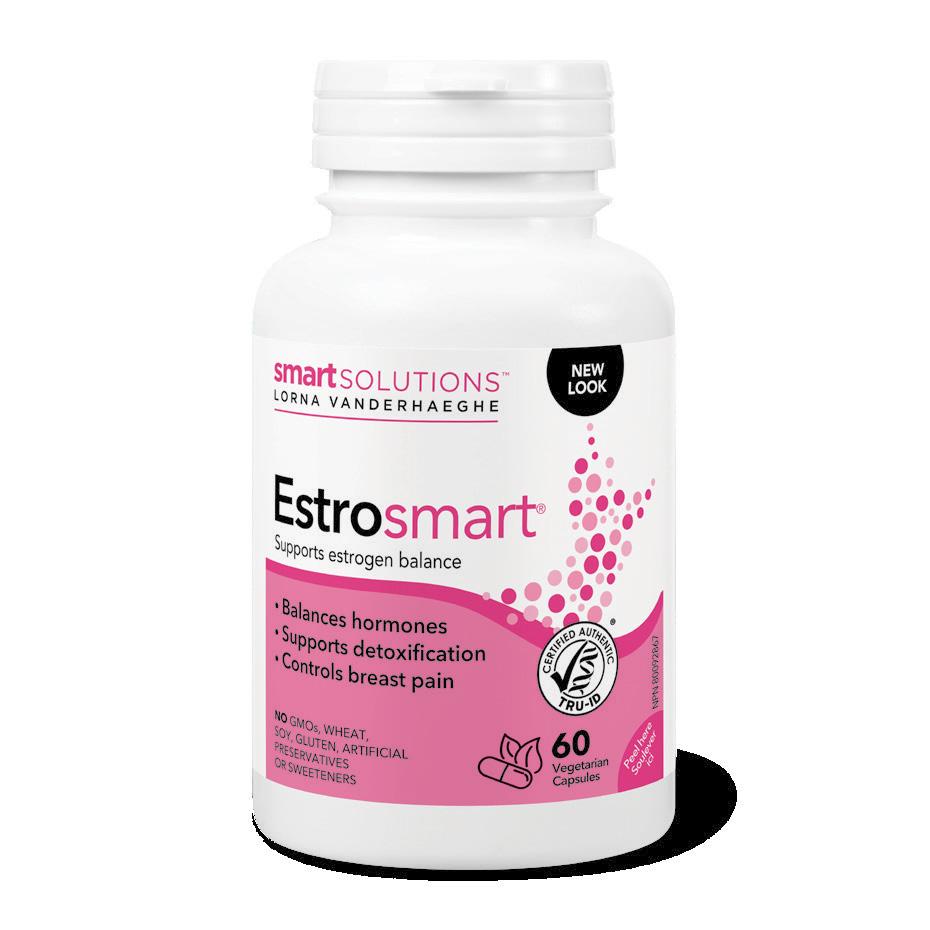


Empowering women’s health


smartsolutionsca
SmartSolutions.com















































































































































































































































































